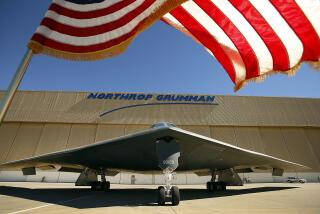Defense Town Awaits Buildup
- Share via
CHINA LAKE — Cupped by towering 14,000-foot Sierra mountains and the barren Mojave Desert, the Navy’s biggest base has no port or ships.
More than 175 miles from the ocean, the Naval Air Weapons Station since the 1940s has been home to one of the Pentagon’s most prized research and development centers.
But for a decade, the Pentagon has been slashing weapon research and the base’s workforce has fallen some 40% to about 4,000. These cutback’s pummeled the economy in Ridgecrest, a town on the southern edge of the base, where the population slid from 37,000 in 1990 to 24,000 and housing prices tumbled.
Few here expected any good news this month when the Pentagon’s nationwide base closing plan was announced. Yet Defense Secretary Donald H. Rumsfeld wants to add 2,500 civilian workers to China Lake. It would be the single largest job increase of any military complex in California, and give the long-suffering town an economic boost.
The proposal is part of a massive Pentagon plan to realign or close 150 military facilities nationwide. It calls for only one of California’s 30 major military bases -- the Naval Surface Warfare Center in Corona -- to be closed.
Congress must still approve the plan in its entirety, although that is expected by the fall. If all goes as planned, the first group of new workers will arrive in China Lake next year; many would come from Navy bases in Virginia and Maryland.
Ridgecrest officials estimate that another 2,500 support jobs also would be created in town.
“We’re very pleased but we’re not gloating,” said Harvey Rose, the city manager. About 80% of the jobs in town have a link to the base, he said. “We know the pain that other communities are feeling.”
City officials are eager for the buildup to help the town return to its heyday when the base was home to 6,000 physicists, chemists, engineers and technicians, many earning high-paying white-collar salaries.
The influx of new civilian employees is part of a broader plan to consolidate much of the Navy’s armament and ordnance development and testing at China Lake. The oversight panel cited the base’s vast expanse of land, clear weather and its remoteness.
These were the same attributes that attracted Caltech and the Navy to the area in 1943. Back then, Caltech had a Navy contract to develop World War II rockets, but it needed an isolated area to test and evaluate them.
Over the decades, physicists and chemists at China Lake have developed or tested virtually every rocket, missile and bomb in the U.S. arsenal, including the explosive components for the first atom bomb.
The site -- best known to many Southern California skiers and campers who drive past it on Interstate 395 on their way to Mammoth Mountain or Yosemite National Park -- is part of the nation’s largest restricted air space.
China Lake’s 1,700 square miles make it about the size of Delaware. Parts of the base are so remote that some engineers who enter the main complex at the southern end must drive more than two hours to their work site. Test ranges are so isolated that scientists have been able to explode a 500,000-pound bomb without being detected. A typical free-falling bomb weighs 2,000 pounds.
“We’re relatively unencumbered by encroachment,” said Capt. Mark Storch, the base commander. “We don’t have that problem here where people are saying, ‘Hey stop flying because you’re making too much noise.’ ”
China Lake got its name after Chinese laborers in the 1870s broke away from a mining company in the nearby mountains before settling along the shores of a dry lake bed.
Today, the base resembles a chemical research center more than a conventional military site -- there are few barracks. About 4,000 people currently work here, including 3,000 civilians, mostly scientists developing and testing new rocket propulsion systems, explosives, detonators and electronic weapons.
As for nearby Ridgecrest, it remains a “Navy town” in the heart of the desert, where restaurants are named after famous sea battles, such as the Midway Cafe, or ports-of-call such as Bangkok’s.
There are still lingering reminders, though, of the 1990s’ downturn visible on the town’s main thoroughfare, China Lake Boulevard, where an empty fast-food restaurant with signs torn off sit next to several homes boarded up with plywood.
“We were in an economic tailspin” a decade ago, Rose said.
“It was very traumatic” during the slump, said Bill Porter, who worked on the base as a civilian engineer for 40 years until retiring in 1993. “In some cases people had to walk away from their homes.”
At one point, Ridgecrest had 700 vacant homes and the average home price dipped to just over $60,000 in 2000 from about $100,000 in 1993.
But the market has picked up in recent years with an influx of retirees lured by the arid climate and the relatively inexpensive homes, local real estate agents said. The increase in the retiree population also has triggered a jump in healthcare providers and churches.
Now, a four-bedroom, two-bath house costs about $200,000. And real estate agents expect another bounce with an influx of new residents who will work at the base.
“We’re going to need a lot more homes,” Porter said. “We don’t have enough homes to take care of the 2,500 new employees.”
More to Read
Sign up for Essential California
The most important California stories and recommendations in your inbox every morning.
You may occasionally receive promotional content from the Los Angeles Times.













